Arthopan 250 mg Tablet 10's
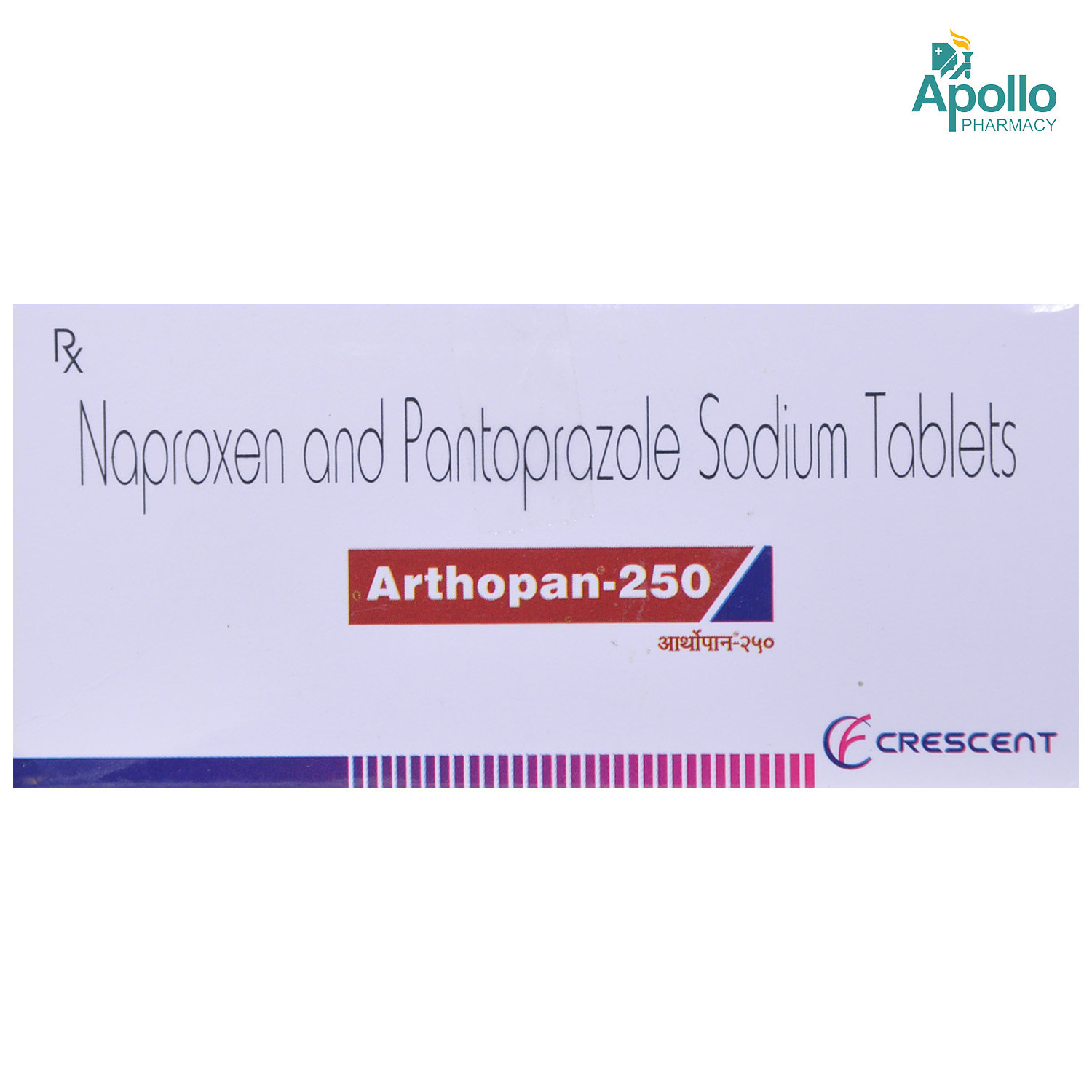
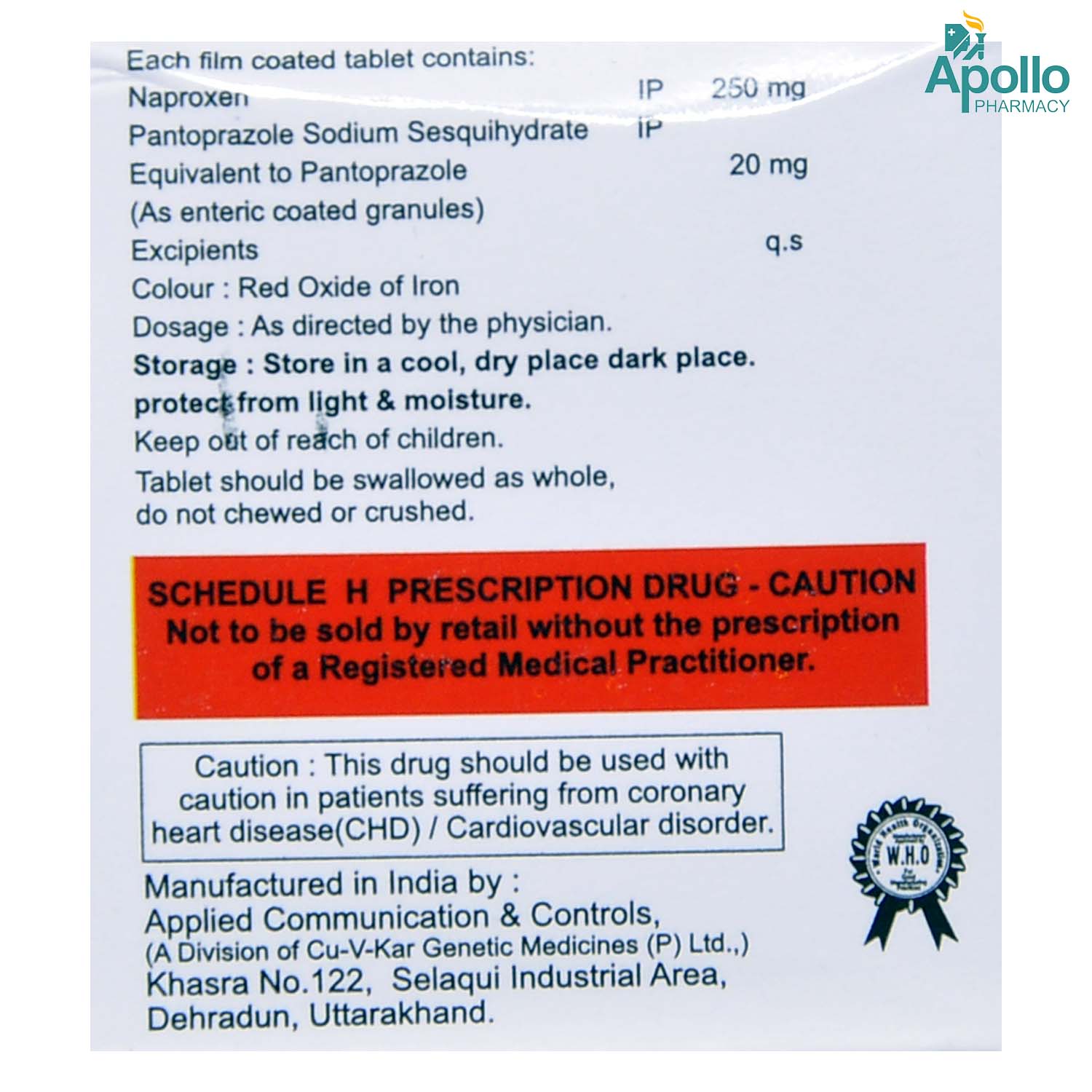
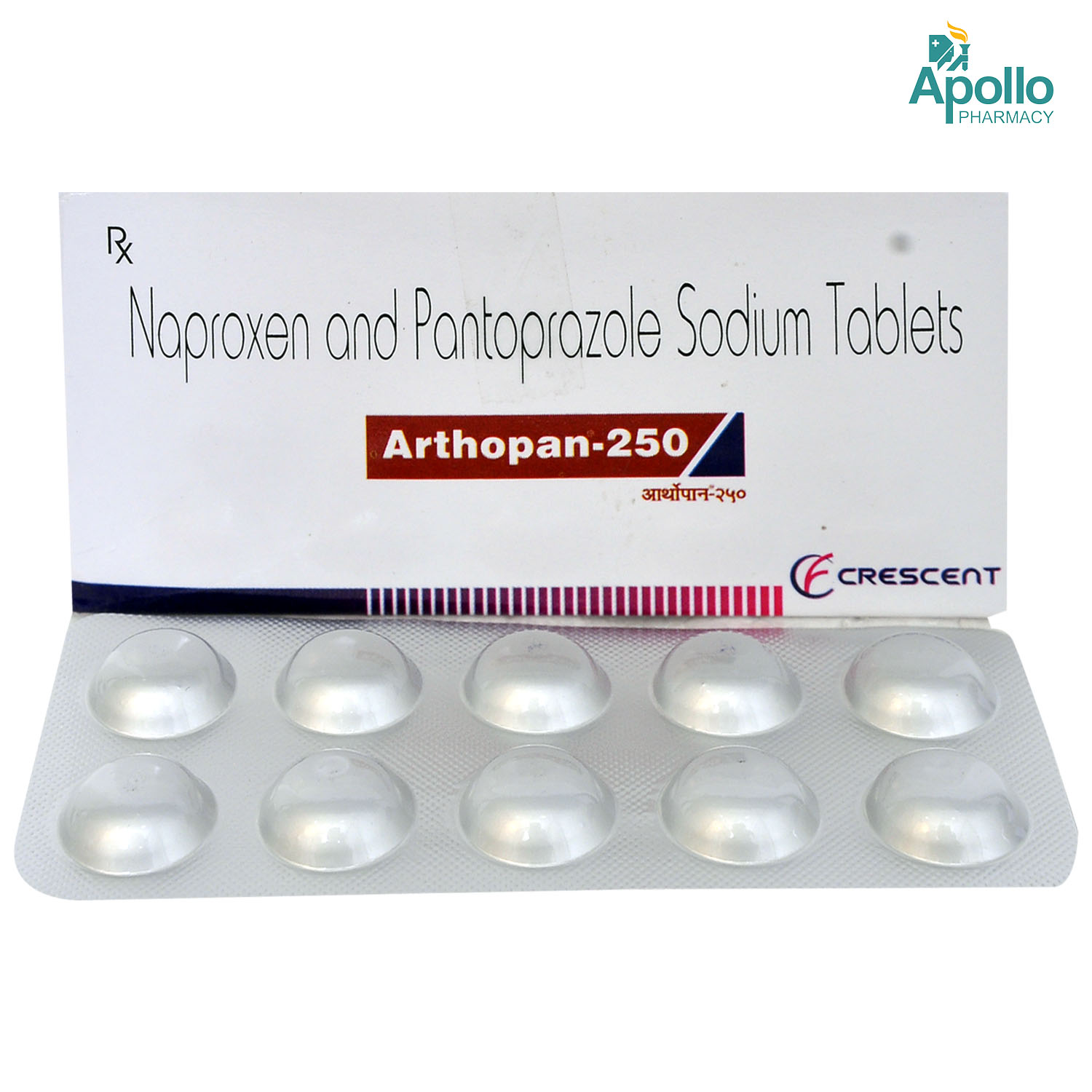
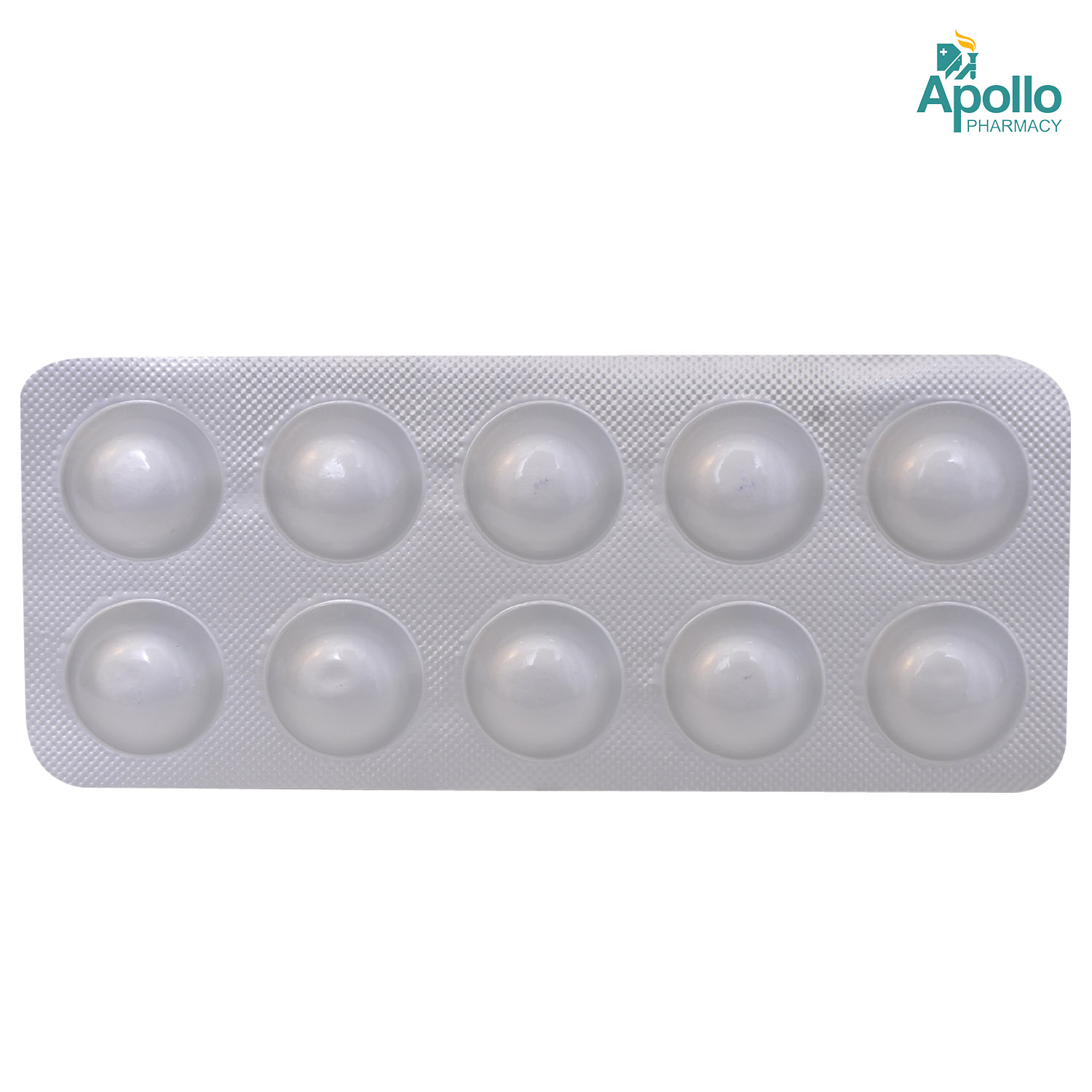
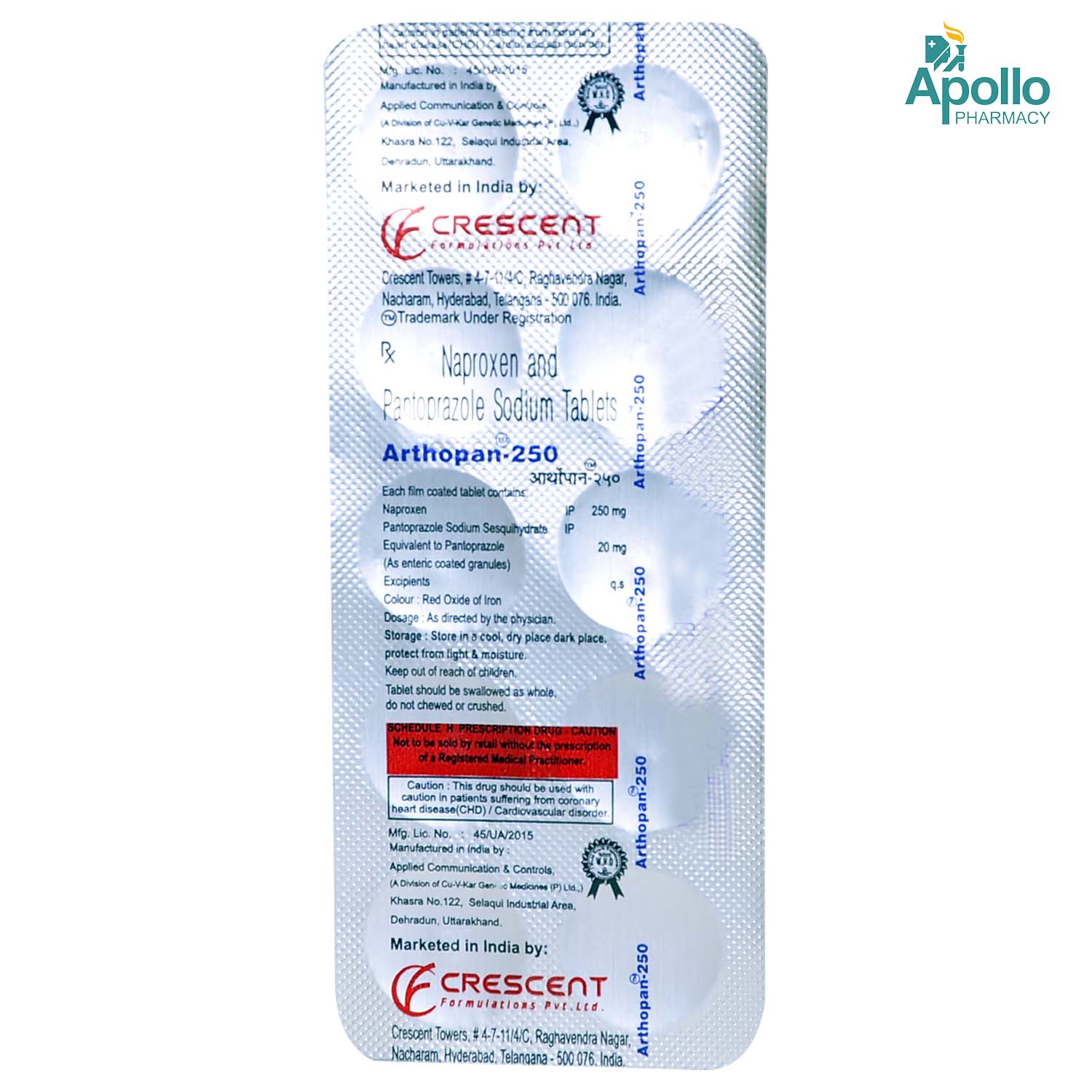





MRP ₹86
(Inclusive of all Taxes)
₹12.9 Cashback (15%)
Provide Delivery Location
Online payment accepted
 Prescription drug
Prescription drugWhats That
Composition :
Manufacturer/Marketer :
Consume Type :
Expires on or after :
Return Policy :
About Arthopan 250 mg Tablet
Arthopan 250 mg Tablet belongs to a group of medicines called Non-Steroidal Anti-Inflammatory Drugs (NSAIDs) or pain killers used to reduce and relieve pain, redness and inflammation (swelling) in patients suffering from osteoarthritis, rheumatoid arthritis and ankylosing spondylitis, cervical spondylitis (wear and tear of spinal discs in neck), dysmenorrhea, mild migraine and acute gout (severe pain due to an excess of uric acid) in adult and children. Rheumatoid arthritis is an autoimmune disease in which the immune system of the body attacks its cells and causes damage, thereby causing joint pain with inflammation.
Arthopan 250 mg Tablet is a combination of two drugs: Naproxen (painkiller) and Pantoprazole (antacid). Naproxen is an anti-inflammatory drug that works by blocking the action of the cyclo-oxygenase (COX) enzyme in the body that is involved in the production of certain chemical substances (prostaglandins) that cause pain and swelling. This helps in reducing mild to moderate pain and inflammation at the injured or damaged site decreasing stiffness in joints. It is also used to treat low back pain, strains, and sprains. Naproxen has been reported to cause gastric discomfort, acidity, and risk of stomach ulcers. Hence, it is combined with Pantoprazole (proton pump inhibitors) which reduces the amount of acid made by the stomach, thus preventing damage to the stomach. Thus, the combination helps alleviate pain with minimal gastric irritation caused due to Naproxen alone.
Take Arthopan 250 mg Tablet as prescribed by your doctor. You are advised to take Arthopan 250 mg Tablet for as long as your doctor has prescribed it for you based on your medical condition. You may experience indigestion, stomach pain, constipation, dizziness, nausea, and diarrhea in some cases. Most of these side effects of Arthopan 250 mg Tablet do not require medical attention and gradually resolve over time. However, if the side effects persist or worsen, please consult your doctor.
Before taking this medicine, inform your doctor if you have any known allergy to naproxen, pantoprazole, other NSAIDs or other medications. If you are pregnant or breastfeeding, please inform your doctor before taking Arthopan 250 mg Tablet . Also, inform the doctor if you have a history of heart rhythm problems or ulcers due to painkillers. Patients with age above 65 years, with pre-existing cardiac diseases such as heart failure, hypertension or stroke, gastrointestinal bleeding (due to pain killers), gastric ulcers, respiratory diseases such as asthma, liver diseases, kidney diseases, or bleeding disorders should use Arthopan 250 mg Tablet only when prescribed by a doctor.
Uses of Arthopan 250 mg Tablet
Directions for Use
Key Benefits
Arthopan 250 mg Tablet is a combination of two drugs, namely: Naproxen is an anti-inflammatory (reduces inflammation) and an analgesic (reduces pain) agent, and Pantoprazole (antacid). Naproxen works by blocking the action of the cyclo-oxygenase (COX) enzyme in the body that is involved in the production of certain chemical substances (prostaglandins) that cause pain and swelling. This helps in reducing mild to moderate pain and inflammation at the injured or damaged site decreasing stiffness in joints. It is also used to treat fibrositis (muscle pain and stiffness), tenosynovitis (swelling of tendons), low back pain, strains and sprains. NSAIDs such as Naproxen have been reported to cause gastric discomfort, acidity, and risk of stomach ulcers. To reduce gastric discomfort and stomach ulceration risk, it is combined with Pantoprazole (a proton pump inhibitor that inhibits gastric acid secretion) to reduce stomach acid production during long-term treatment for people with pre-existing stomach ulcers or for people having a history of developing stomach ulcers while using NSAIDs. Thus, the combination helps alleviate pain with minimal gastric irritation caused due to Naproxen alone.
Storage
- Inform your doctor about the nausea and discuss possible alternatives to the medication or adjustments to the dosage.
- Divide your daily food intake into smaller, more frequent meals to reduce nausea.
- Opt for bland, easily digestible foods like crackers, toast, plain rice, bananas, and applesauce.
- Avoid certain foods that can trigger nausea, such as fatty, greasy, spicy, and smelly foods.
- Drink plenty of fluids, such as water, clear broth, or electrolyte-rich beverages like coconut water or sports drinks.
- Use ginger (tea, ale, or candies) to help relieve nausea.
- Get adequate rest and also avoid strenuous activities that can worsen nausea.
- Talk to your doctor about taking anti-nausea medication if your nausea is severe.
- Record when your nausea occurs, what triggers it, and what provides relief to help you identify patterns and manage your symptoms more effectively.
- Take medications with food (if recommended): It can help prevent stomach distress and indigestion.
- Eat smaller, more frequent meals: Divide daily food intake into smaller, more frequent meals to ease digestion.
- Avoid trigger foods: Identify and avoid foods that trigger indigestion, such as spicy, fatty, or acidic foods.
- Stay upright after eating: Sit or stand upright for at least 1-2 hours after eating to prevent stomach acid from flowing into the oesophagus.
- Avoid carbonated drinks: Avoid drinking carbonated beverages, such as soda or beer, which can worsen indigestion.
- Manage stress: To alleviate indigestion, engage in stress-reducing activities like deep breathing exercises or meditation.
- Consult a doctor if needed: If indigestion worsens or persists, consult a healthcare professional to adjust the medication regimen or explore alternative treatments.
- Inform your doctor about dizziness symptoms. They may adjust your medication regimen or prescribe additional medications to manage symptoms.
- Follow your doctor's instructions for taking medication, and take it at the same time every day to minimize dizziness.
- When standing up, do so slowly and carefully to avoid sudden dizziness.
- Avoid making sudden movements, such as turning or bending quickly, which can exacerbate dizziness.
- Drink plenty of water throughout the day to stay hydrated and help alleviate dizziness symptoms.
- If you're feeling dizzy, sit or lie down and rest until the dizziness passes.
- Track when dizziness occurs and any factors that may trigger it, and share this information with your doctor to help manage symptoms.
- Hydrate your body: Drink enough water to prevent dehydration and headaches.
- Calm Your Mind: Deep breathing and meditation can help you relax and relieve stress.
- Rest and Recharge: Sleep for 7-8 hours to reduce headache triggers.
- Take rest: lie down in a quiet, dark environment.
- Cold or warm compresses can help reduce tension.
- Stay Upright: Maintain good posture to keep symptoms from getting worse.
- To treat headaches naturally, try acupuncture or massage therapy.
- Over-the-counter pain relievers include acetaminophen and ibuprofen.
- Prescription Assistance: Speak with your doctor about more substantial drug alternatives.
- Severe Headaches: Seek emergency medical assistance for sudden, severe headaches.
- Frequent Headaches: If you get reoccurring headaches, consult your doctor.
- Headaches with Symptoms: Seek medical attention if your headaches include fever, disorientation, or weakness.
Drug Warnings
Do not take Arthopan 250 mg Tablet if you are allergic to Arthopan 250 mg Tablet . Long-term use of nonsteroidal anti-inflammatory drugs (NSAIDs) (other than aspirin) such as naproxen may increase the risk of heart attack or stroke and stomach ulcers. The risk of developing ulcers is higher if you have a history of ulcers, have bleeding disorders, older in age, alcoholic or have multiple diseases. Elderly patients are at greater risk for gastrointestinal bleeding problems so the doctor can limit their dose. It should not be used by a patient who has undergone recent heart bypass surgery or going to have it. Arthopan 250 mg Tablet is not recommended for pregnant women especially in the third trimester as it may cause harm to the baby. Therefore, pregnant or breastfeeding women are advised to consult a doctor before taking Arthopan 250 mg Tablet . Consult your doctor before giving Arthopan 250 mg Tablet to children. Do not take any other NSAIDs for pain relief along with Arthopan 250 mg Tablet unless prescribed. Prolonged intake of PPIs or proton pump inhibitors like pantoprazole may cause brittle bones so intake of Vitamin D and calcium can be additionally given by your doctor while using Arthopan 250 mg Tablet . Do not consume alcohol with Arthopan 250 mg Tablet as it may increase the risk of stomach bleeding or ulcer.
Drug-Drug Interactions
Drug-Drug Interactions
Login/Sign Up
Co-administration of Rilpivirine is taken with Arthopan 250 mg Tablet, can decrease the absorption and blood levels of Rilpivirine and make the medication less effective.
How to manage the interaction:
Taking Arthopan 250 mg Tablet with Rilpivirine can lead to an interaction, please consult a doctor before taking it. Do not stop using any medications without talking to a doctor.
Coadministration of Ketorolac with Arthopan 250 mg Tablet can increase the risk or severity of gastric bleeding and ulceration.
How to manage the interaction:
Taking Ketorolac with Arthopan 250 mg Tablet together is generally avoided as it can possibly result in an interaction, it can be taken if your doctor has advised it. However, if you notice any unusual bleeding or bruising, other signs of bleeding, dizziness, lightheadedness, red or black tarry stools, coughing up or vomiting blood, severe headache, and weakness, you should contact your doctor immediately. Do not stop using any medications without first talking to your doctor.
Co-administration of Arthopan 250 mg Tablet with Meloxicam can increase the risk or severity of gastric bleeding, ulceration, and rarely, perforation leading to serious blood loss.
How to manage the interaction:
Taking Meloxicam with Arthopan 250 mg Tablet is not advised as it can possibly result in an interaction, it can be taken if your doctor has advised it. You should seek immediate medical attention if you experience any unusual bleeding or bruising or have other signs and symptoms of bleeding such as dizziness; lightheadedness; red or black, tarry stools; coughing up or vomiting fresh or dried blood that looks like coffee grounds; severe headache; and weakness.
Taking cidofovir with Arthopan 250 mg Tablet may increase the risk or severity of kidney problems
How to manage the interaction:
Taking Arthopan 250 mg Tablet with Cidofovir is generally avoided as it can possibly result in an interaction. You should seek immediate medical attention if you develop signs and symptoms such as nausea, vomiting, loss of hunger, increased or decreased urination, sudden weight gain or weight loss, fluid retention, swelling, shortness of breath, bone pain, muscle cramps, tiredness, weakness, dizziness, confusion, and irregular heart rhythm.
Taking Gefitinib with Arthopan 250 mg Tablet reduces the acidity level in the stomach and may interfere with the absorption of Gefitinib and reduce its effectiveness.
How to manage the interaction:
Taking Arthopan 250 mg Tablet with Gefitinib together can possibly result in an interaction, it can be taken if your doctor has advised it. You are recommended to take gefitinib 12 hours before or 12 hours after Arthopan 250 mg Tablet to help minimize the impact of the interaction. Do not discontinue the medication without consulting a doctor.
Taking Arthopan 250 mg Tablet with Pazopanib may reduce the effectiveness of pazopanib.
How to manage the interaction:
If you are supposed to take Arthopan 250 mg Tablet and Pazopanib together, but can be taken together if prescribed by a doctor. However, if you experience any unusual symptoms contact your doctor immediately. Do not stop using any medications without first talking to your doctor.
Taking Nelfinavir with Arthopan 250 mg Tablet may decrease the absorption and blood levels of Nelfinavir and reduce its effectiveness.
How to manage the interaction:
Taking Arthopan 250 mg Tablet with Nelfinavir together can possibly result in an interaction, but it can be taken if a doctor has advised it. A doctor can recommend other options that won't cause any problems when taken together. Do not stop using any medications without a doctor's advice.
Taking Erlotinib with Arthopan 250 mg Tablet may interfere with the absorption of Erlotinib into the bloodstream, and reduce its effectiveness.
How to manage the interaction:
Taking Arthopan 250 mg Tablet with Erlotinib together can possibly result in an interaction, but it can be taken if a doctor has advised it. A doctor can recommend other options that won't cause any problems when taken together. Do not stop using any medications without a doctor's advice.
Taking Dasatinib with Arthopan 250 mg Tablet may decrease the blood levels of Dasatinib and reduce its effectiveness.
How to manage the interaction:
Taking Arthopan 250 mg Tablet with Dasatinib together can result in an interaction, but it can be taken if a doctor has advised it. In case of any unusual side effects, contact a doctor. Do not stop using any medications without a doctor's advice.
Taking Arthopan 250 mg Tablet can make Dacomitinib less effective by reducing its absorption in the body.
How to manage the interaction:
Taking Arthopan 250 mg Tablet with Dacomitinib together can possibly result in an interaction, but it can be taken if a doctor has advised it. A doctor can recommend other options that won't cause any problems when taken together. Do not stop using any medications without a doctor's advice.
Drug-Food Interactions
Drug-Food Interactions
Login/Sign Up
Diet & Lifestyle Advise
- Physical activity helps in strengthening muscles and relieves joint stiffness. Gentle activities like 20-30minutes of walking or swimming would be helpful.
- Performing yoga may also help in improving joint flexibility and pain management.
- Maintain a healthy weight by performing regular low-strain exercises and eating healthy food.
- Get adequate sleep as resting the muscles can help in reducing inflammation and swelling.
- Follow heat or cold therapy, and apply a cold or hot compress on the joints for 15-20minutes regularly.
- Acupuncture, massage, and physical therapy may also be helpful.
- Foods containing flavonoids such as soy, berries, broccoli, grapes, and green tea help in reducing inflammation.
- Include high-fiber-containing foods, berries, cherries, leafy green veggies, and black peppers in your meal. These foods are full of antioxidants, calcium, and vitamin B12 that can help cope with the long-term effects of the medicine. Fermented dairy products like miso, sauerkraut, and kimchi contain probiotics which help in the prevention of excess stomach acid production.
- Avoid intake of acid or heartburn-triggering foods or drinks like onions, peppermint, chocolate, caffeinated beverages, citrus fruits or juices, tomatoes, and high-fat and spicy foods.
- Avoid smoking and alcohol consumption.
Side Effects of Arthopan 250 mg Tablet
- Indigestion
- Stomach pain
- Constipation
- Dizziness
- Nausea
- Vomiting
- Kidney dysfunction
- Diarrhoea
Habit Forming
Therapeutic Class
All Substitutes & Brand Comparisons
RX
Out of StockNaprowin-P 250 Tablet 10's
Basilwin Pharmaceuticals Llp
₹89
(₹8.9 per unit)
14% COSTLIER
Product Substitutes
Author Details
We provide you with authentic, trustworthy and relevant information
Drug-Diseases Interactions
Drug-Diseases Interactions
Login/Sign Up
FAQs
Arthopan 250 mg Tablet contains Naproxen (non-steroidal anti-inflammatory drug or pain reliever) and Pantoprazole (antacid). Naproxen works by blocking the release of certain chemical messengers (prostaglandins) that cause pain and inflammation (redness and swelling). Pantoprazole works by blocking the action of the enzyme known as the gastric proton pump that is responsible for the production of acid. This helps in reducing the amount of acid produced, heals the ulcers and prevents the formation of new ulcers.
No, you are not recommended to take Arthopan 250 mg Tablet with clopidogrel as co-administration of these two medicines may increase the risk of bleeding more easily. However, if you notice blood in urine or stools, dizziness, unusual bleeding or bruising, vomiting, weakness or headache, please consult a doctor immediately. If you are supposed to use these medicines together, you are advised to contact your doctor so that the dose may be adjusted appropriately to use safely.
Yes. Arthopan 250 mg Tablet can alter certain medical tests like neuroendocrine tumours (secretin stimulation test) and urine screening tests for tetrahydrocannabinol (THC). So before undergoing such a diagnostics test contact your doctor.
Yes, Naproxen in Arthopan 250 mg Tablet may increase the risk of heart problems such as heart attack and stroke especially when used in high doses or for a prolonged duration. It is advised to inform your doctor if you have any of these conditions or have a history of heart problems or stroke before taking Arthopan 250 mg Tablet . However, it is recommended to take Arthopan 250 mg Tablet in dose and for the duration as prescribed by your doctor. It should be not used by the patient who have had recent heart bypass surgery (coronary artery bypass graft - CABG).
Arthritis is a chronic condition of joints with pain and inflammation. Arthopan 250 mg Tablet does not cure arthritis but relieve symptoms of arthritis-like joint pain, swelling and stiffness.
Arthopan 250 mg Tablet is a pregnancy Category C medicine so, it is advisable to tell your doctor before its intake. It may inhibit ovulation (release of egg from ovary) and decrease the levels of progesterone leading to infertility in women. However, this effect is temporary and ovulation returns to normal mostly after one month of stopping Arthopan 250 mg Tablet . However, if you are planning for pregnancy or have difficulties becoming pregnant, please inform your doctor before taking Arthopan 250 mg Tablet .
Drug-Drug Interactions Checker List
- IBUPROFEN
- DICLOFENAC
- PARACETAMOL
- ASPIRIN
- PROPRANOLOL
- ENALAPRIL
- LOSARTAN
- CANDESARTAN
- FUROSEMIDE
- HEPARIN
- WARFARIN
- CLOPIDOGREL
- PHENYTOIN
- GLIMEPIRIDE
- GLIPIZIDE
- MOXIFLOXACIN
- CIPROFLOXACIN
- AMPICILLIN
- RIFAMPICIN
- ZIDOVUDINE
- ATAZANAVIR
- NELFINAVIR
- KETOCONAZOLE
- VORICONAZOLE
- ITRACONAZOLE
- POSACONAZOLE
- DIGOXIN
- METHOTREXATE
- CILAZAPRIL
- EPROSARTAN
Special Advise
- If you are elderly, a smoker, had stroke previously, or have high blood pressure, diabetes, or high cholesterol, please inform your doctor as these conditions may increase the risk of heart problems.
- Your doctor may monitor liver function and kidney function if you are taking Arthopan 250 mg Tablet for long-term.
- Individuals at risk for osteoporosis-related fractures should receive an adequate intake of calcium and vitamin D.
- Pantoprazole in Arthopan 250 mg Tablet may interfere with certain laboratory tests (including urine test for tetrahydrocannabinol-THC, and a blood test to find certain tumors), possibly causing false test results. Make sure laboratory personnel and all your doctors know you are using Arthopan 250 mg Tablet .
- Regular monitoring of vitamin B-12, rarely, Pantoprazole in Arthopan 250 mg Tablet have caused vitamin B-12 deficiency. The risk is increased if they are taken Arthopan 250 mg Tablet every day for a long time.
Disease/Condition Glossary
Osteoarthritis: It is a degenerative joint disease in which the two ends of the joints come together due to breakdown of a protective covering of cartilage. Due to the absence of this protective covering, the joints rub against each other, leading to pain and stiffness. Symptoms of osteoarthritis include pain, stiffness, inflammation and tenderness. The main reason for osteoarthritis is age, the older you are, the more likely you could get osteoarthritis, thus known as degenerative disease, meaning that the joints wear out as a person ages. Other reasons include a past injuries such as torn cartilage, dislocated joints, and ligament injuries.
Rheumatoid arthritis: It is an auto-immune disease (the body's immune system attacks its tissue) that leads to joint pain and damage. Symptoms of rheumatoid arthritis include pain, swelling, stiffness, deformities, and loss of joint function.
Ankylosing spondylitis: It causes pain and stiffness in the spine. The pain usually starts in the lower back and can spread to the neck, damaged joints, or other parts of the body. Symptoms of ankylosing spondylitis include decreased flexibility which usually leads to a hunched-forward posture, pain, and back and joints.
Migraine: A headache of varying intensity, often accompanied by nausea and sensitivity to light and sound.
Gout: A form of arthritis characterized by severe pain, redness, and tenderness in joints. Pain and inflammation occur when too much uric acid crystallizes and deposits in the joints.

Have a query?
Buy best C.n.s Drugs products by
Intas Pharmaceuticals Ltd
Sun Pharmaceutical Industries Ltd
Torrent Pharmaceuticals Ltd
Alkem Laboratories Ltd
Abbott India Ltd
Cipla Ltd
Alteus Biogenics Pvt Ltd
Micro Labs Ltd
Lupin Ltd
Ipca Laboratories Ltd
D D Pharmaceuticals Pvt Ltd
Icon Life Sciences
Mankind Pharma Pvt Ltd
Tripada Healthcare Pvt Ltd
Arinna Lifesciences Ltd
Linux Laboratories Pvt Ltd
East West Pharma India Pvt Ltd
La Renon Healthcare Pvt Ltd
Talent India Pvt Ltd
Tas Med India Pvt Ltd
Zydus Healthcare Ltd
Cnx Health Care Pvt Ltd
Eris Life Sciences Ltd
Leeford Healthcare Ltd
Emcure Pharmaceuticals Ltd
Macleods Pharmaceuticals Ltd
Sigmund Promedica
Aristo Pharmaceuticals Pvt Ltd
Dr Reddy's Laboratories Ltd
Troikaa Pharmaceuticals Ltd
Consern Pharma Ltd
Zydus Cadila
Shine Pharmaceuticals Ltd
Wockhardt Ltd
Ardent Life Sciences Pvt Ltd
Crescent Formulations Pvt Ltd
Theo Pharma Pvt Ltd
Reliance Formulation Pvt Ltd
Ikon Pharmaceuticals Pvt Ltd
Propel Healthcare
Neon Laboratories Ltd
Jagsam Pharma
Msn Laboratories Pvt Ltd
Morepen Laboratories Ltd
Pulse Pharmaceuticals
Sanofi India Ltd
Med Manor Organics Pvt Ltd
Hetero Healthcare Pvt Ltd
Novartis India Ltd
Crescent Therapeutics Ltd
Elder Pharmaceuticals Ltd
Solvate Laboratories Pvt Ltd
Akumentis Healthcare Ltd
Mova Pharmaceutical Pvt Ltd
Psyco Remedies Ltd
Tripada Lifecare Pvt Ltd
Ajanta Pharma Ltd
Cyrus Remedies Pvt Ltd
Medishri Healthcare Pvt Ltd
Cadila Healthcare Ltd
Glenmark Pharmaceuticals Ltd
Matteo Health Care Pvt Ltd
Hbc Life Sciences Pvt Ltd
Lyf Healthcare
Matias Healthcare Pvt Ltd
Mesmer Pharmaceuticals
Alembic Pharmaceuticals Ltd
Capital Pharma
Crescent Pharmaceuticals
Medopharm Pvt Ltd
Alniche Life Sciences Pvt Ltd
Kivi Labs Ltd
Talin Remedies Pvt Ltd
USV Pvt Ltd
Quince Lifesciences Pvt Ltd
Solis Pharmaceuticals
Infivis Life Care
Zuventus Healthcare Ltd
Cadila Pharmaceuticals Ltd
Pfizer Ltd
Wallace Pharmaceuticals Pvt Ltd
A N Pharmacia Laboratories Pvt Ltd
Blue Cross Laboratories Pvt Ltd
Jenburkt Pharmaceuticals Ltd
Lia Life Sciences Pvt Ltd
Mano Pharma
Medley Pharmaceuticals Ltd
Primus Remedies Pvt Ltd
FDC Ltd
Maneesh Pharmaceuticals Ltd
Apex Laboratories Pvt Ltd
Gagnant Healthcare Pvt Ltd
Ozone Pharmaceuticals Ltd
RPG Life Sciences Ltd
Strides Shasun Ltd
Unichem International
GlaxoSmithKline Pharmaceuticals Ltd
Kuresys Labs Pvt Ltd
LA Pharma
Trion Pharma India Llp
Alcohol
Safe if prescribed
You are recommended to avoid consumption of alcohol with Arthopan 250 mg Tablet as it may increase the risk of stomach bleeding and ulcer.
Pregnancy
Consult your doctor
Arthopan 250 mg Tablet is a Category C pregnancy drug and is considered unsafe for pregnant women especially in the third trimester. However, please consult your doctor if you are pregnant.
Breast Feeding
Consult your doctor
Arthopan 250 mg Tablet passes into the breast milk. However, no evidence of risk has been reported. Please consult your doctor before intake of Arthopan 250 mg Tablet . Your doctor will weigh the benefits and any potential risks before prescribing it to you.
Driving
Safe if prescribed
Arthopan 250 mg Tablet may cause dizziness, tiredness, drowsiness or vision problems in some people. So, drive only if you are alert after taking Arthopan 250 mg Tablet .
Liver
Consult your doctor
Arthopan 250 mg Tablet should be used with caution in people having liver diseases. Dose adjustments may be necessary. So, it should be used only with your doctor's prescription.
Kidney
Consult your doctor
Arthopan 250 mg Tablet is not recommended for use in patients with moderate to severe and severe renal impairment. The dose may be adjusted by your doctor as required. So, it should be used only when prescribed by your doctor.
Children
Safe if prescribed
Arthopan 250 mg Tablet can be used safely in children if prescribed by a doctor.





